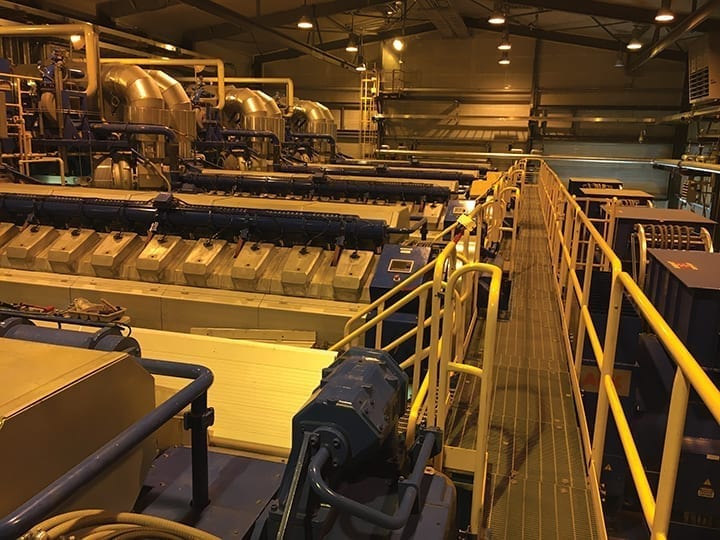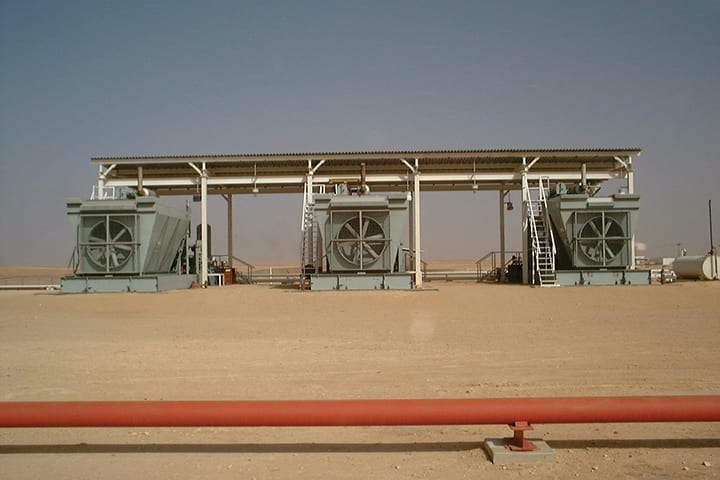Environmental Legislation and Stationary Gas Engines
As countries around the world set more stringent emissions standards, stationary gas engine operators are often required to incorporate new technology into their equipment. The changes can affect lubricants, so it’s important to evaluate all options.
The 2015 Paris Agreement charted a new course to tackle emissions, and combined with evidence of pollutants being on the rise, the net result is swiftly imposed legislation to curb them. Add into the mix consumer pressure for industry and governments to demonstrate their commitment to tackling emissions directly resulting from human activity, and it’s no surprise that despite their clean reputation, stationary gas engines are increasingly subject to legislative parameters. However, there is little consistency from country to country.
Norway uses a carbon tax to curb emissions, while Mexico empowers operators to choose how to achieve facility-wide emissions reductions from a centrally dictated baseline. Each approach poses a tradeoff between flexibility, compliance certainty, and environmental impact.
As a global frontrunner in natural gas production, Natural Resources Canada continues to implement joint actions with provinces and territories under the Canadian Energy Strategy, and the approach is bottom up—the rules are enacted provincially and organized by component or activity. They comprise targeted site-specific interventions such as replacing or controlling individual high-emitting components and inspecting equipment for methane leaks.
The Alberta government in Western Canada has been ahead of this curve, having imposed new reporting and monitoring requirements for sweet gas processing plants in 1996, under environmental health policy. The scale of the province’s output puts into context why this was the case; Alberta alone produced 72% of the marketable natural gas in Canada in 2017. The code of practice requires operators to monitor and report on nitrous oxide levels by each facility, using several acceptable measures, one being the U.S.’s Environmental Protection Agency, which is a demonstration of Canada’s natural gas markets being heavily integrated with those in the U.S.
Decisions for Operators
As demands on different states and provinces grow to demonstrate their commitment in tackling pollutants, an evolving landscape of legislative tweaks in turn requires operators to remain poised to adapt to new requirements whilst running efficient, profitable plants. Managing emissions has been a long-term concern for plant operators. Indeed, effective control of resulting emissions is crucial to efficient and sustainable running of operations to ultimately protect the bottom line. Legislative direction is further incentive; not primary motivation.
Furthermore, controlling pollutants is also not unique to either newer or older engines. Incomplete combustion results in carbon monoxide and carbon dioxide, and the combustion process also results in emissions of nitrous oxide or sulfur dioxide. Faced with this challenge, operators may take one of two routes; to invest in new technologies to reduce emissions, or to continue with traditional engines that use catalytic converters. Both require specialized maintenance programs and regular intervention to mitigate impacts on performance. Additionally, both scenarios impact the stationary gas engine oil and require several careful considerations to be made.
Clean Technology
One result of such legislative drives is an increased motivation to invest in new technology to reduce emissions. In many countries there are tax incentives to do so, but equally there are several factors to consider as they are not without their associated challenges.
First, whilst newer engines burn hotter and cleaner, rather than being emitted, the resulting byproducts—sulfur dioxide, carbon monoxide, carbon dioxide, and nitrous oxide—end up in the oil. Forward-thinking lubricant companies, such as Petro-Canada Lubricants, have responded with ranges of tougher oils to deal with the byproducts and avoid increased downtime.
Second, cleaner emission oils are limited by ash levels too. It is almost ironic that while the detergent in the oil protects the valves from wear and recession, it’s the detergent that can also contribute to excessive ash buildup. If the ash is allowed to build up in the combustion chamber, it will eventually get pulled down into the crankcase and cause cylinder liner wear. As well, the extremely hot operating temperatures of these engines means the very hot oil will start to oxidize or nitrate early. These oxidation and nitration byproducts will shorten the lifespan of the oil, in turn meaning more changes and downtime. Lubricant companies are under pressure to develop oils that can withstand the nitration and oxidation.
Catalytic Converters
Selecting the correct oil remains important for companies seeking to clean up their act by applying catalytic converters to their engines. Failing to do so could result in plugging off of the catalytic converter, resulting in lost time and money.
Paradoxically, the issue arises from the anti-wear additives, as well as the sulfated ash level, in the stationary gas engine oil (Figure 1). Zinc and phosphorus are needed to protect the engine, but having a catalytic converter on the backend limits how much of this additive can be used—too much phosphorus will contaminate it. The danger of this happening over time, and without adequate monitoring, will result in the converter no longer working. Too much ash will cause a plugging of the catalytic converter, resulting in higher backpressure on the exhaust, and could result in the engine backfiring.
 |
|
1. Oil viscosity and sulfated ash levels are important in achieving optimum engine performance. The Wartsila engines shown here were supplied with a formulation meeting the highest industry standards, designed to protect equipment even under severe stress caused by fluctuating workloads. Courtesy: Petro-Canada Lubricants |
Securing Engine Performance
While government regulations evolve in the background, achieving optimum engine performance is the focal point for operators. No matter the route chosen to adhere to codes of practice, there are practical steps that can be taken to balance maintenance, performance, and environmental demands.
First, the stationary gas lubricant selected must have the correct viscosity and sulfated ash levels. There are no industry standards for stationary gas engine oil quality. The American Petroleum Institute (API) classification for automotive oils doesn’t apply, so the original equipment manufacturer (OEM) specification and field experience are the primary measures for defining it.
The intense heat and potential fluctuating workload of a stationary gas engine puts the oil under severe stress (Figure 2). No corners can be cut. Compared to diesel, natural gas will not produce soot. Its dry state can cause ash deposits, which in turn affect preignition, detonation, and exhaust valve wear. The extent of the damage can be immense, meaning sulfated ash is the primary consideration for oil selection. When making their decision, operators are essentially balancing between combustion chamber cleanliness and protection.
 |
|
2. The compressors shown here are located in Algeria and require specially formulated lubricants to deal with the unique demands placed on the oil. Courtesy: Petro-Canada Lubricants |
There are several factors affecting ash deposit accumulations, including engine make and model, engine load, fuel gas composition, the way the engine is set up, as well as the oil consumption rate. While the operation manual will specify the viscosity and sulfated ash levels, it is prudent for operators to consider other factors, and if unsure, to seek advice from a technical expert. Getting ash levels wrong can quickly become detrimental to performance.
Second, it is imperative that the engine is always correctly tuned to ensure low levels of nitration and oxidation. If nitration or oxidation occur, the resulting sludge, varnish, and viscosity—and eventual corrosion—will cost time and money.
The answer is to burn the precise balance of air to fuel; hitting the right air-to-fuel ratio will give more control over resulting nitration levels. For stationary gas engines, stoichiometric ratios vary with fuel gas composition and will usually be from 16:1 to 16.5:1, where one gram of fuel requires about 16 grams of air. Particular models run at different levels of lean or rich burn.
Tuning of the engine makes an enormous difference. This is where the skills and attention of the mechanical team come into play. If a rich-burn engine burns just lean of stoich, it will tend to have excess nitration, which will require an oil that’s nitration resistant. If it’s a lean or ultra-lean engine, oxidation will occur, which could determine a different lubricant, and if the engine has been running at a very low load, lube oil degradation won’t occur to the same extent. The variants can be minor but the impact huge. Correct setting of the crankcase pressure will ensure removal of combustion by-gases, which prolongs engine service life.
The third is undertaking regular used-oil analysis (UOA). Having clear sight of what the engine is experiencing is crucial to making an informed lubricant choice based on the model of the engine and its load. By doing this right, operators can extend drain intervals, and therefore reduce downtime. Technical advisors know how different models of engines will behave, but the margins for making a markable difference to engine performance are small, so taking into account the history of the engine’s performance and undertaking regular oil analysis are what will ensure optimum performance.
Operators should apply best-practice principles of UOA, such as adhering to the suite of standardized industry-accepted test methods set by ASTM International, the International Organization for Standardization (ISO), and for European engine manufacturers, Deutsches Institut für Normung (DIN). There are a number of key properties specific to an engine that need to be considered when undertaking UOA of stationary gas engines if it is to give the operator all the possible information and performance indicators.
Testing should include viscosity, oxidation, and nitration, as previously explored; the total acid number (TAN); initial pH, which is particularly important in landfill and biogas applications; the total base number (TBN), a measure of alkalinity that is most relevant to diesel engine oils, which have higher amounts of detergents, but can and should be used in stationary gas engine oils as required by the manufacturer; and finally, water. Water is a very detrimental contaminant in a gas engine oil. Not only does water reduce the film strength of the oil, it is also a catalyst for oxidation; as explored, it is a major risk for stationary gas engines, and causes rust and corrosion.
The Environmental Landscape
Environmentally motivated demands on stationary gas engine operators are evolving and are in many ways unpredictable. Reacting adequately is not straightforward, but as outlined, there are concrete steps that operators can take to ensure they are well-placed to respond.
Lubricant companies are on this journey as much as operators. The ask of companies, such as Petro-Canada Lubricants, to develop new technology lines in answer to mechanical developments, which in turn are fueled by legislative demands, demonstrates the tight-knit nature of the energy production ecosystem. ■
—Terry Veenstra is senior technical services advisor with Petro-Canada Lubricants.